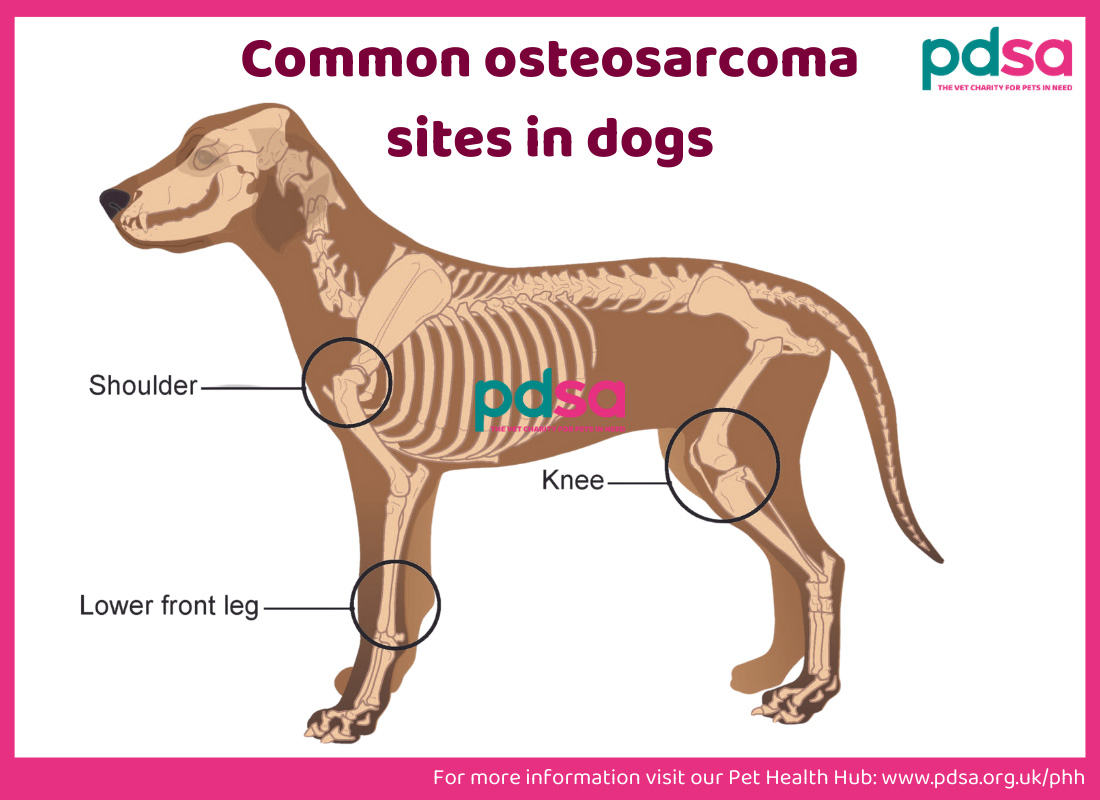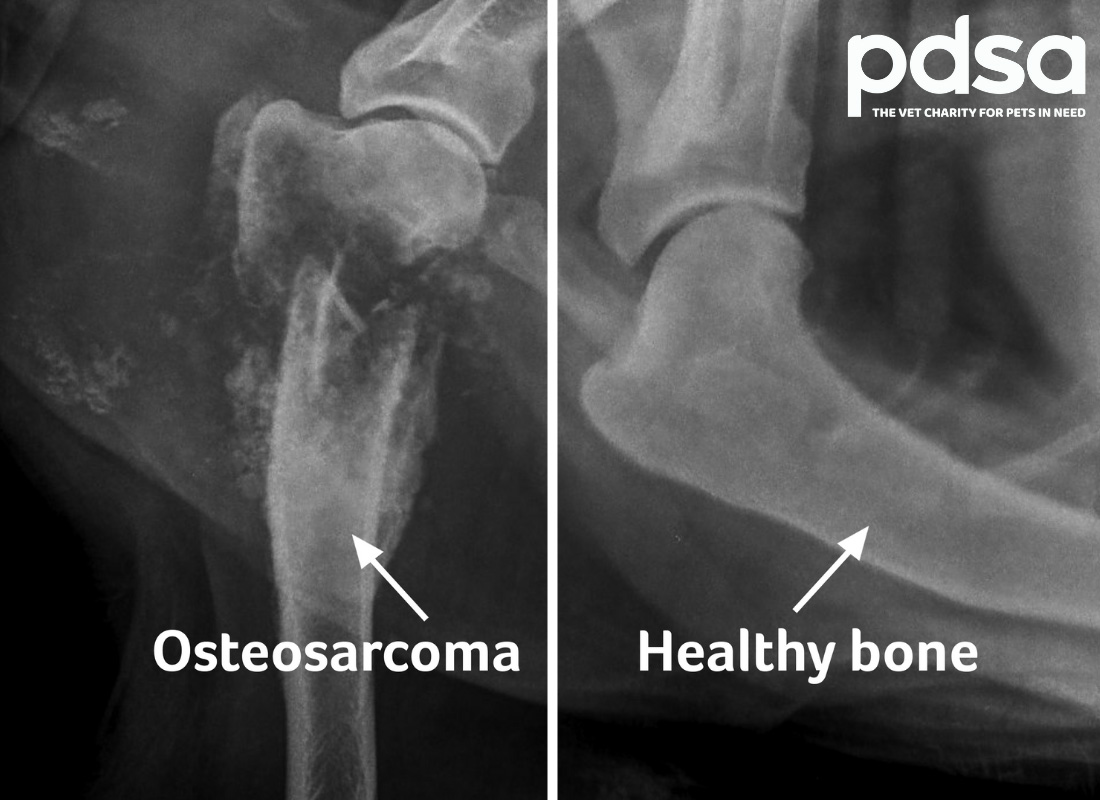Osteosarcoma (bone cancer) in dogs
Overview
- The most common type of bone cancer in dogs is ‘osteosarcoma’.
- Osteosarcoma tumours usually appear as hot, solid, painful swellings. They are most common in leg bones, but can affect any bone in the body.
- Giant breed dogs are most at risk of developing an osteosarcoma.
- Osteosarcomas are often aggressive tumours that spread quickly to other parts of the body such as the lungs.
- Sadly, the outlook for a dog with an osteosarcoma is very poor.
- There are other, less common types of bone cancer. The prognosis and treatment for each of these depend on which one your dog has been diagnosed with.
What is an osteosarcoma?
Osteosarcoma is the most common type of bone cancer found in dogs. It’s a painful and aggressive bone cancer that spreads quickly around the body (usually via the bloodstream). An osteosarcoma can develop in any bone, but they are most common in leg bones (see diagram).
Osteosarcoma tumours destroy the bone around them, sometimes causing them to break (we call this a ‘pathological fracture’).
They are most common in middle aged, large and giant breeds such as Irish Wolfhounds, Greyhounds and Rottweilers.

Symptoms of bone cancer in dogs
Osteosarcomas can cause the following symptoms:
- Limping (varies from mild to severe)
- A painful, hot, hard swelling (usually on a leg)
- An unexpected leg fracture
- Low energy (lethargy)
- Reduced appetite
- If the osteosarcoma is on your dog’s jaw you may notice:
- A swelling in the jaw bone
- A painful mouth
- A lump in the mouth
- Difficulty eating
- Discharge from the nose
Diagnosis
X-rays, and sometimes bone samples, are necessary to confirm an osteosarcoma diagnosis. Your vet may also suggest more specialist tests such as a CT (computed tomography) scan to check if the cancer has caused any obvious tumours elsewhere in the body, such as the lungs, liver and kidneys. This is usually done at a specialist referral center.
Sadly, even if your vet doesn’t see any obvious tumours on a scan, it doesn’t mean the cancer hasn’t spread. Over 90% of osteosarcomas have spread around the body at the time of diagnosis - the tumours are often just too small to detect on scans.
Treatment and outlook
Osteosarcoma is the most common type of bone cancer so we will focus on the treatment and outlook for this.
Sadly, if your dog has an osteosarcoma, their outlook is very poor. At the time of diagnosis most osteosarcomas (over 90%), have spread to other parts of the body. Without treatment, most dogs need to be put to sleep within a few weeks of diagnosis, or possibly much less than a few weeks if the tumour is causing pain, or has caused a fracture. There are certain palliative (symptom relieving) treatments that can be used to temporarily extend life and reduce pain, but it’s important to be aware that these treatments usually aren’t a cure.
Surgery
Surgery usually means amputating the affected leg. Amputation provides pain relief from the tumour, and gives an average life expectancy of four to six months afterwards. However, amputation comes with its own challenges, so it’s important to think seriously about how your dog would cope afterwards – some cope very well, but others struggle to adapt.
If you don’t think your dog would cope with three legs but want to try treatment, in some very specific circumstances, it’s possible to remove an osteosarcoma without amputation by removing the affected section of bone and replacing it with an implant. This type of surgery is only done at specialist referral centres and gives a similar life expectancy to amputation (four to six months). It’s important to be aware that this type of surgery has a high risk of complications, such as infection and the cancer returning in the same bone.
Chemotherapy
Chemotherapy can be used alongside surgery to control the spread of your dog’s cancer, and extend their life for a bit longer but it’s important to know that it won’t cure them. Sadly, even with surgery and chemotherapy, most dogs survive less than a year after diagnosis.
Considering your options
Every dog with an osteosarcoma is different, so your dog’s treatment will be tailored to suit them as an individual. Due to the seriousness of the condition, and the relatively short life expectancy (even with treatment), deciding on a treatment plan can be an extremely emotional and difficult thing to do. It’s important to speak openly and honestly with your vet, and to stay focused on pain relief and maintaining a good quality of life for you dog.
If at any point during their treatment plan, your dog’s quality of life drops, and their pain becomes uncontrollable, euthanasia is the kindest option. Your vet will discuss all your options and offer advice about when it is time to say goodbye.

Cost
Treatment for an osteosarcoma can become very expensive, so it’s important to speak openly with your vet about the cost of treatment, your finances, and what you think is right for your dog. There is sometimes more than one treatment option, so if one doesn’t work for you/your dog then your vet may be able to offer another.
Consider taking out dog insurance as soon as you bring your dog home, before any signs of illness start. This will give you peace of mind that you have some financial support if they ever become unwell.
Can bone cancer in dogs be cured?
Sadly, osteosarcoma is very aggressive and has nearly always spread to other parts of the body by the time it is diagnosed. There are certain palliative (symptom relieving) treatments that can be used to temporarily extend life and reduce pain, but it’s important to be aware that these treatments usually aren’t a cure
Is bone cancer in dogs painful?
Yes, bone cancer is a very painful condition. Your vet will discuss the most suitable pain relief options for your dog.
Published: January 2024
Did you find this page useful?
Tell us more
Please note, our vets and nurses are unable to respond to questions via this form. If you are concerned about your pet’s health, please contact your vet directly.
Thank you for your feedback
Want to hear more about PDSA and get pet care tips from our vet experts?
Sign up to our e-newsletter
Written by vets and vet nurses. This advice is for UK pets only. Illustrations by Samantha Elmhurst.

